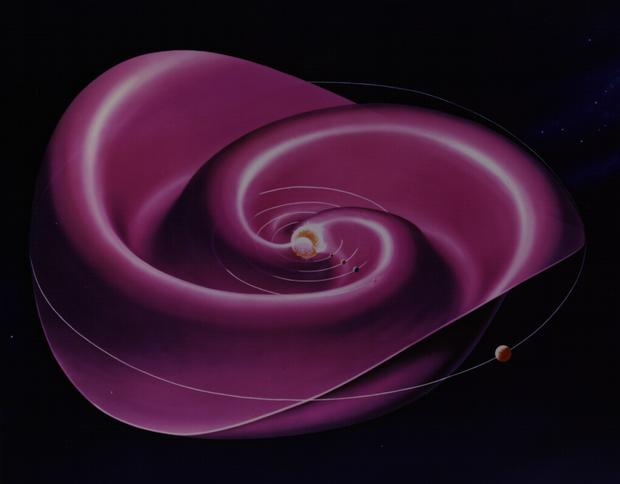The sun's vast magnetic field is about to flip.
The sun's magnetic field changes polarity approximately every 11 years, at the peak of each solar cycle as the sun's inner magnetic dynamo re-organizes itself. The coming reversal will mark the midpoint of Solar Cycle 24, which means half of 'Solar Max' will be behind us, with half yet to come.
Todd Hoeksema is the director of Stanford University's Wilcox Solar Observatory, one of the few observatories in the world that monitor the sun's polar magnetic fields. The poles are a herald of change. Just as Earth scientists watch our planet's polar regions for signs of climate change, solar physicists do the same thing for the sun.
Magnetograms at Wilcox have been tracking the sun's polar magnetism since 1976, and they have recorded three grand reversals—with a fourth in the offing.
"It looks like we're no more than 3 to 4 months away from a complete field reversal," says Hoeksema. "This change will have ripple effects throughout the solar system."
A reversal of the sun's magnetic field is, literally, a big event. The domain of the sun's magnetic influence (also known as the "heliosphere") extends billions of kilometers beyond Pluto. Changes to the field's polarity ripple all the way out to the Voyager probes, on the doorstep of interstellar space.
When solar physicists talk about solar field reversals, their conversation often centers on the "current sheet." The current sheet is a sprawling surface jutting outward from the sun's equator where the sun's slowly-rotating magnetic field induces an electrical current. The current itself is small, only one ten-billionth of an amp per square meter (0.0000000001 amps/m2), but there’s a lot of it: the amperage flows through a region 10,000 km thick and billions of kilometers wide. Electrically speaking, the entire heliosphere is organized around this enormous sheet.
During field reversals, the current sheet becomes very wavy. Scherrer likens the undulations to the seams on a baseball. As Earth orbits the sun, we dip in and out of the current sheet. Transitions from one side to another can stir up stormy space weather around our planet.

The heliospheric current sheet separates regions of the solar wind where the magnetic field points toward or away from the Sun. The complex field structure in the photosphere simplifies with increasing height in the corona until a single line separates the two polarities at about 2.5 solar radii. That line is drawn out by the radially accelerating solar wind to form a surface similar to the one shown in this idealized picture. The surface is curved because the underlying magnetic pattern rotates every 27 days with the Sun. It would take about 3 weeks for material near the current sheet traveling at 400 km/s in the solar wind to reach the orbit of Jupiter, as depicted here. In reality the surface becomes increasingly distorted because of variations in the solar wind speed along the surface and other dynamic effects operating in the interplanetary medium. The shape of the current sheet usually evolves slowly - over months - as the large-scale pattern of the Sun's field changes in response to the emergence and decay of solar active regions. Coronal mass ejections often disrupt the background pattern temporarily, but sometimes the changes are permanent. During most of the solar cycle the current sheet is basically a tilted dipole with varying degrees of quadrupole distortion. Near solar maximum the dipole decays leaving a much more complicated structure. This picture shows the heliospheric current sheet as it might appear during the rising phase of the cycle, when the dipole and quadrupole components are balanced; at this point the neutral line at the base of the sheet resembles the seam on a baseball. Prof. John M. Wilcox was one of the discoverers of the heliospheric current sheet and did much to develop our understanding of it during the 1960s and 1970s. He worked with NASA artist Werner Heil to create this picture. The shape for this solar rotation was based on Ken Schatten's Current Sheet Magnetic Model for the Solar Corona (Cosmic Electrodynamics, 2, 232-245, 1971). An early 3D rendering of the HCS appeared in a 1976 paper by L. Svalgaard and J.M. Wilcox in Nature (Vol 262, page 766).
Cosmic rays are also affected. These are high-energy particles accelerated to nearly light speed by supernova explosions and other violent events in the galaxy. Cosmic rays are a danger to astronauts and space probes, and some researchers say they might affect the cloudiness and climate of Earth. The current sheet acts as a barrier to cosmic rays, deflecting them as they attempt to penetrate the inner solar system. A wavy, crinkly sheet acts as a better shield against these energetic particles from deep space.
As the field reversal approaches, data from Wilcox show that the sun's two hemispheres are out of synch.
"The sun's north pole has already changed sign, while the south pole is racing to catch up," says solar physicist Phil Scherrer, also at Stanford. "Soon, however, both poles will be reversed, and the second half of Solar Max will be underway."






Comments